VMMakarSakranti
Makar Sankranti![]() (VideoofMakar Sankranti celebration)
(VideoofMakar Sankranti celebration)
Makar Sankranti is a festival celebrated in the southern region of India during the lunar month of Poush, which corresponds to January. Similar to Lohri, it begins the harvesting season for farmers
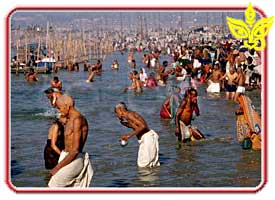 and is celebrated at the end of the Winter Solstice. This festival is significant to Hindus because it serves as a transition between the six months of light (Rama, or Heaven) and the six months of darkness (Ravana, or Hell). Makar Sankranti also pays homage to Saraswati, the goddess of knowledge and art. On the day before Makar Sankranti, those celebrating the festival go through their homes and throw out everything which is old and has lost meaning, getting ready for the transition to a new season and new things. Families give gifts to friends and neighbors as a sign of love.
and is celebrated at the end of the Winter Solstice. This festival is significant to Hindus because it serves as a transition between the six months of light (Rama, or Heaven) and the six months of darkness (Ravana, or Hell). Makar Sankranti also pays homage to Saraswati, the goddess of knowledge and art. On the day before Makar Sankranti, those celebrating the festival go through their homes and throw out everything which is old and has lost meaning, getting ready for the transition to a new season and new things. Families give gifts to friends and neighbors as a sign of love.
Profile prepared by Josh Jolly
May, 2009
VMNavatri
Navratri![]() (Video of the Garba dance at Navatri)
(Video of the Garba dance at Navatri)
Navratri is the Festival of Dance and Worship in Hinduism. It is celebrated over ten days and nine nights during which different forms of Shakti (the female divine force) are worshiped. Like most other Hindu festivals, the dates on which Navratri is observed are determined by the Lunar calendar; celebration occurs in the Hindu calendar month or Ashwin, which corresponds to early October. There are numerous regional variations in the way that the festival is celebrated and in the events that take place. On the first three days, the goddess Durga is worshiped; this ritual is believed to remove devotees’ impurities and sins and make them clean. On the second three days, Lakshmi (the goddess of wealth) is worshipped for her power of blessing devotees with unlimited wealth. The final three days are spent worshipping Sarasvati, the goddess of wisdom.
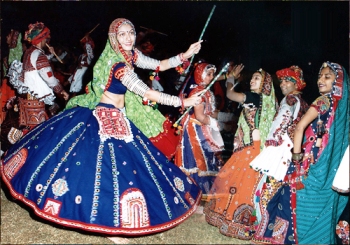 Traditionally, Navratri is celebrated with Garba, a dance that originated from the Gujarat state in India. Participants move in a designated motion with a wooden stick in each hand, clapping them together as they move from dancer to dancer. Participants eventually complete the circle and return to the position from which they started. The dance usually lasts for several hours and is performed on two nights during the festival. Navratri celebrations involve numerous bright colors and candles and lavish decorations.
Traditionally, Navratri is celebrated with Garba, a dance that originated from the Gujarat state in India. Participants move in a designated motion with a wooden stick in each hand, clapping them together as they move from dancer to dancer. Participants eventually complete the circle and return to the position from which they started. The dance usually lasts for several hours and is performed on two nights during the festival. Navratri celebrations involve numerous bright colors and candles and lavish decorations.
VMPanchaGanapati
Pancha Ganapati, which originated in 1985, is the five-day Winter Solstice celebration for Hindus and is observed from the 21st through 25th of December. During this time Hindus pray to Ganesha, the elephant-headed, five-faced, four-armed God. Pancha (five) refers to Ganesha’s five faces, each of which represents a particular type of shakti (power) representing a specific power. One face is worshiped on each of the five days. Ganesha is worshiped as the Remover of Obstacles, and the festival symbolizes new beginnings and starting over.
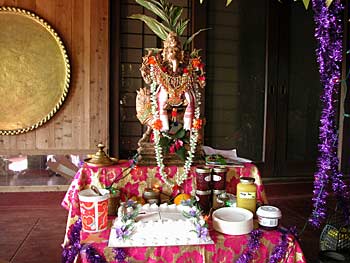 During the festival, a shrine is created in the main living room of the home and decorated in the spirit of this festive occasion. At the center of the shrine is an elaborate murti (statue) of Lord Pancha Ganapati that is decorated with numerous ornaments and garments. Each morning during the festival, fruits and sweets are presented to Ganesha. Every morning the children of the house add a new color to the statue, each with its own significance. On the first day, the color yellow is added to the statue, which signifies love and harmony within the family. Family members sit together, seek to repair strained relationships, offer one another amends and forgiveness, and relate the good qualities the each possesses. On the second day, blue is added to the statue, which signifies the relationship families have with their neighbors. On
During the festival, a shrine is created in the main living room of the home and decorated in the spirit of this festive occasion. At the center of the shrine is an elaborate murti (statue) of Lord Pancha Ganapati that is decorated with numerous ornaments and garments. Each morning during the festival, fruits and sweets are presented to Ganesha. Every morning the children of the house add a new color to the statue, each with its own significance. On the first day, the color yellow is added to the statue, which signifies love and harmony within the family. Family members sit together, seek to repair strained relationships, offer one another amends and forgiveness, and relate the good qualities the each possesses. On the second day, blue is added to the statue, which signifies the relationship families have with their neighbors. On
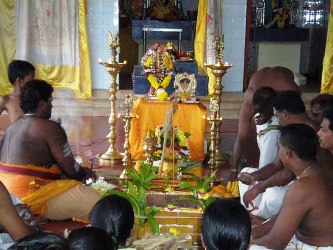 this day, families present gifts and food to their neighbors as a sign of love and respect; apologies and made and forgiveness sought for misunderstandings that may have occurred. On the third day, red is added, representing the love and respect individuals have with their business associates. Gifts are given to employers, employees, customers, and business partners; debts and disputes are settled. On the fourth day, green is added to the statue, representing the art and music the family enjoys. Gifts are again exchanged. Gifts from the previous four days remain unopened and are placed in front of the statue. On the fifth day, the large number of gifts in front of the statue symbolize the amount of love that each individual receives and Ganesh’s grace. On the fifth and final day, orange is added to the statue and represents the combined love from the first three days.
this day, families present gifts and food to their neighbors as a sign of love and respect; apologies and made and forgiveness sought for misunderstandings that may have occurred. On the third day, red is added, representing the love and respect individuals have with their business associates. Gifts are given to employers, employees, customers, and business partners; debts and disputes are settled. On the fourth day, green is added to the statue, representing the art and music the family enjoys. Gifts are again exchanged. Gifts from the previous four days remain unopened and are placed in front of the statue. On the fifth day, the large number of gifts in front of the statue symbolize the amount of love that each individual receives and Ganesh’s grace. On the fifth and final day, orange is added to the statue and represents the combined love from the first three days.
Profile prepared by Josh Jolly
May, 2009
VMRamaNavami
Rama Navami![]() (Rama Navami Celebration)
(Rama Navami Celebration)
Rama Navami is a Hindu Festival that is celebrated in the lunar calendar month of Chaitra, which falls in April. Rama Navami is the celebration of the birth of Lord Rama. In Hindu legend, the king of Ayodhya, Dasarath, had three wives. Being afraid that he would not leave a male heir, a priest was asked to pray that Dasarath would give birth to at least one son. All three wives conceived at the same time, all boys, and the third wife had twins. The first son born to Dasarath was Lord Rama, who is the seventh incarnation of Lord Vishnu and who is revered for his courage, compassion, and religious devotion.
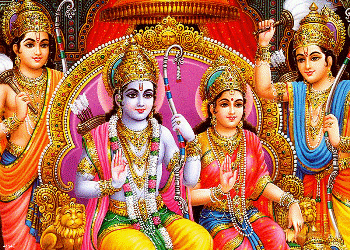 The Rama Navami festival lasts about nine days. During the festival, Hindus travel to temples and sing kirtans and bhajans, elaborate songs that tell stories of the Gods. There is also usually pujas and aartis, prayers that praise Lord Rama. After the prayers are complete, Prasad is served as a way to show respect and love to Lord Rama. In the morning, Hindus will attend temple to prepare, making food and setting up decorations. Because it is believed that Lord Rama was born at noon, there are special prayers at that time. Some Hindus choose to fast during the day, and many give offerings to Lord Rama statues throughout the day, including flowers, fruits and sweets. Many Hindus decide to get married during this time, as it is regarded as very auspicious.
The Rama Navami festival lasts about nine days. During the festival, Hindus travel to temples and sing kirtans and bhajans, elaborate songs that tell stories of the Gods. There is also usually pujas and aartis, prayers that praise Lord Rama. After the prayers are complete, Prasad is served as a way to show respect and love to Lord Rama. In the morning, Hindus will attend temple to prepare, making food and setting up decorations. Because it is believed that Lord Rama was born at noon, there are special prayers at that time. Some Hindus choose to fast during the day, and many give offerings to Lord Rama statues throughout the day, including flowers, fruits and sweets. Many Hindus decide to get married during this time, as it is regarded as very auspicious.
Profile prepared by Josh Jolly
May, 2009
VMUgadi
Ugadi
Ugadi marks the beginning of a new Hindu lunar calendar and is the festival for New Year’s day. The new year begins in the month of Chaitra, which corresponds to March/April. The festival therefore represents new beginnings and new life. The festival is celebrated somewhat differently by the people of Karnataka and Andhra Pradesh, who term the festival Ugadi, and those of Maharashtra, who term the festival Gudi.
 For those that celebrate Ugadi day, rising early, bathing and decorating the entrance of the home with fresh mango leaves is characteristic. There is then an extended family gathering and an elaborate feast. Gudi refers to a bamboo staff that contains a colored sik cloth and is topped by a goblet with a garland. The gudi symbolizes achievement. For those who celebrate Gudi, the day begins with bathing and prayer and is followed by a special mean that contains bitter, tangy, sour, spicy, sweet and salty tastes that symbolize the diversity of life experiences. The meal is followed by a reading from a sacred text that is believed to bring good fortune in the coming year.
For those that celebrate Ugadi day, rising early, bathing and decorating the entrance of the home with fresh mango leaves is characteristic. There is then an extended family gathering and an elaborate feast. Gudi refers to a bamboo staff that contains a colored sik cloth and is topped by a goblet with a garland. The gudi symbolizes achievement. For those who celebrate Gudi, the day begins with bathing and prayer and is followed by a special mean that contains bitter, tangy, sour, spicy, sweet and salty tastes that symbolize the diversity of life experiences. The meal is followed by a reading from a sacred text that is believed to bring good fortune in the coming year.
Profile prepared by Josh Jolly
May, 2009
